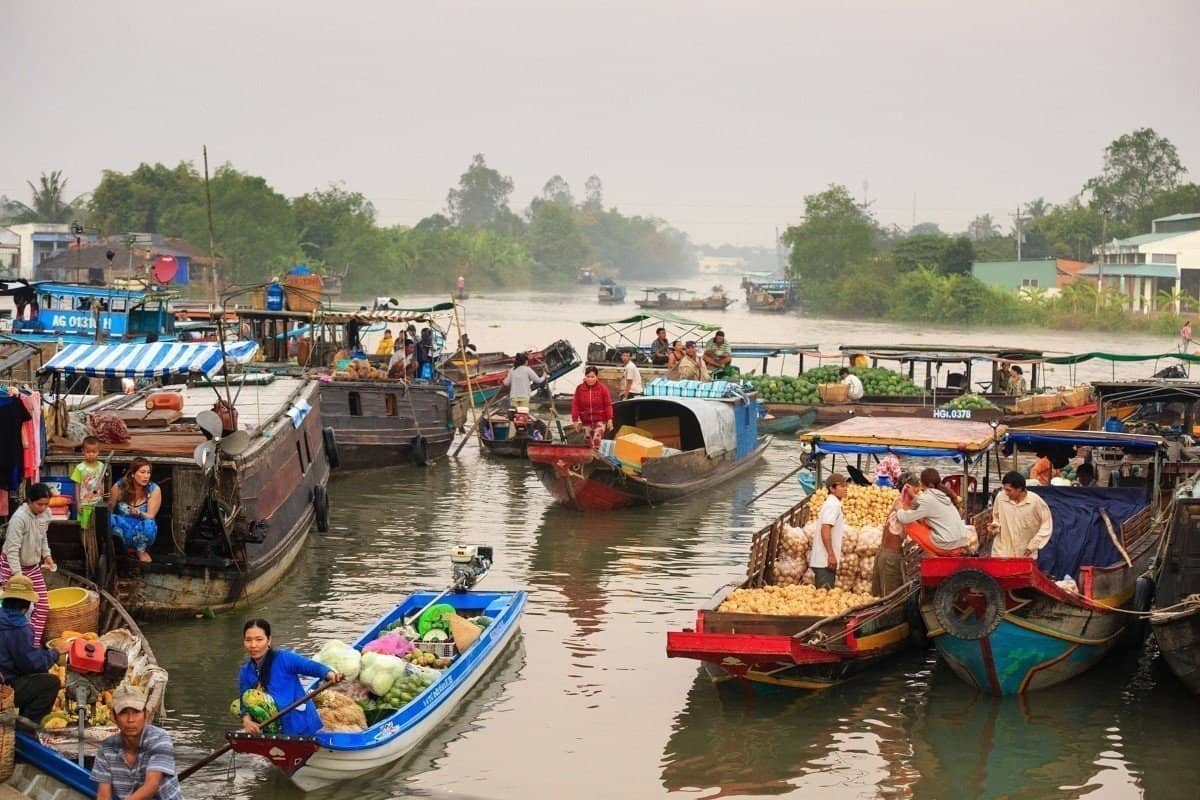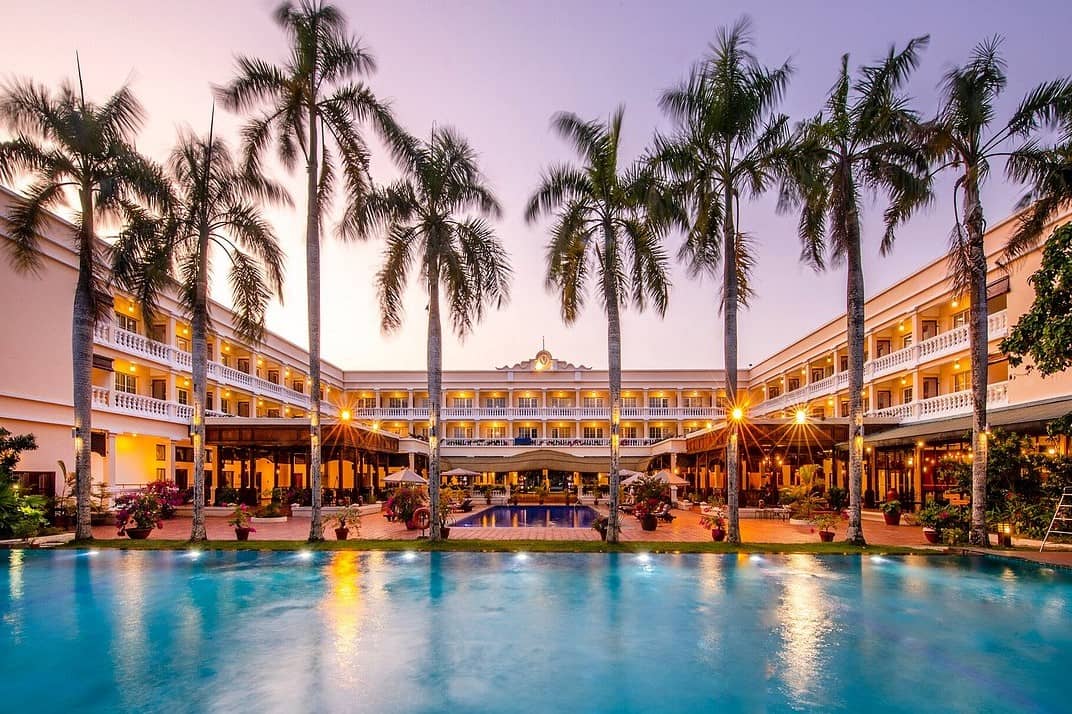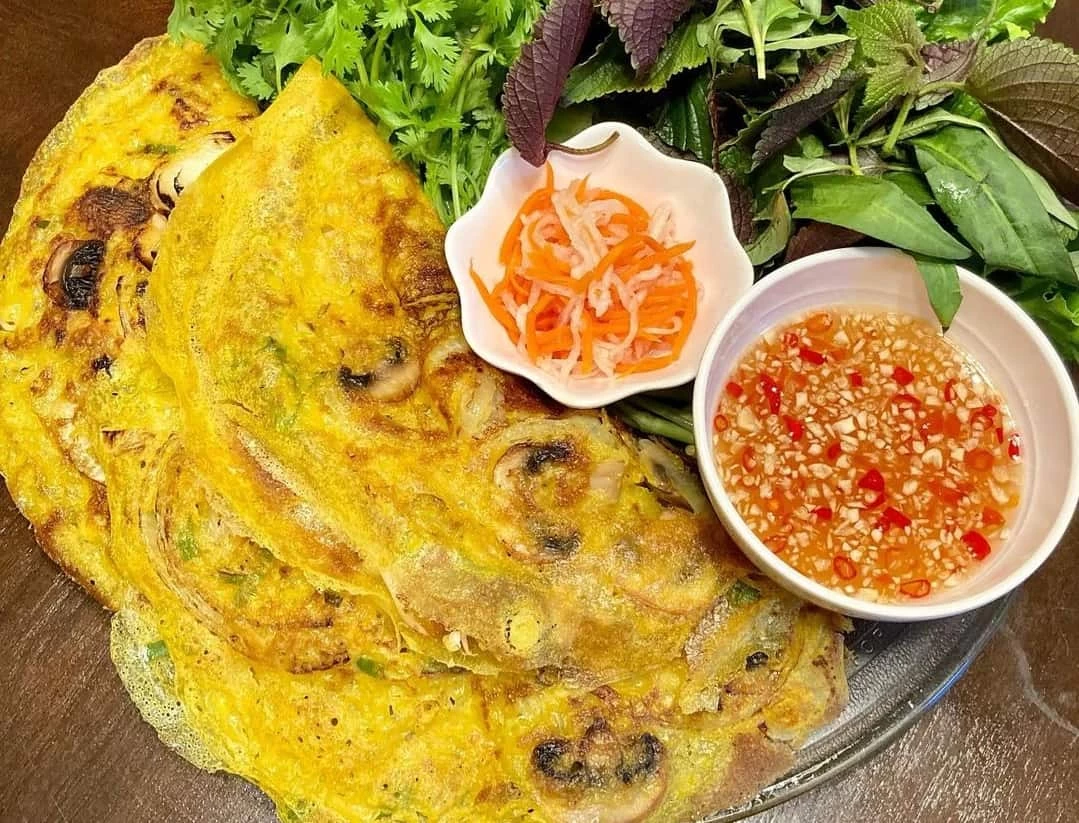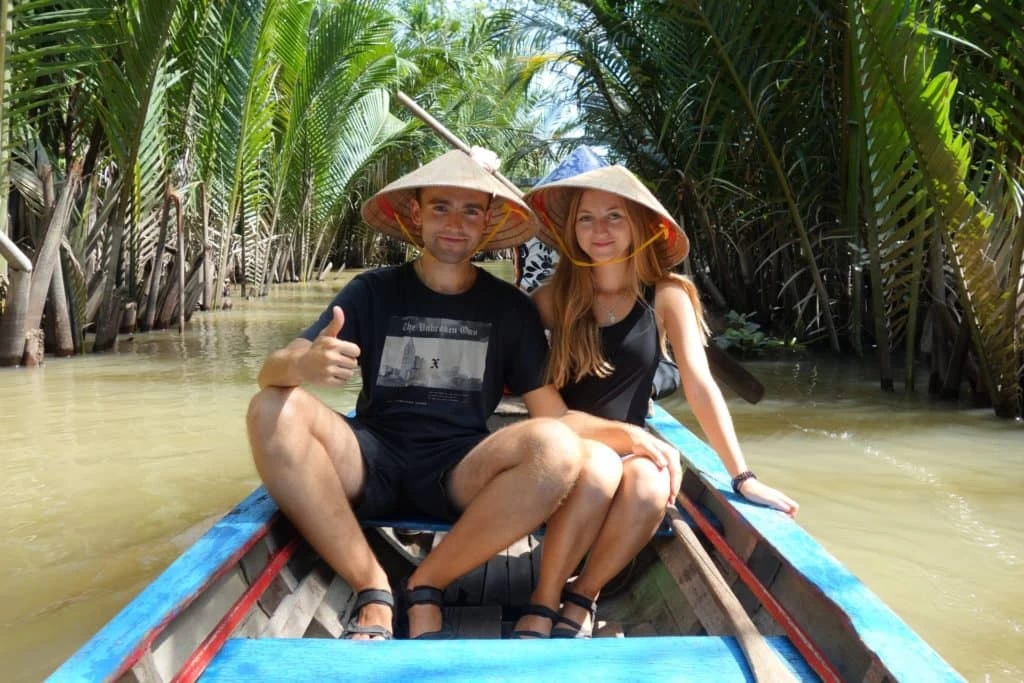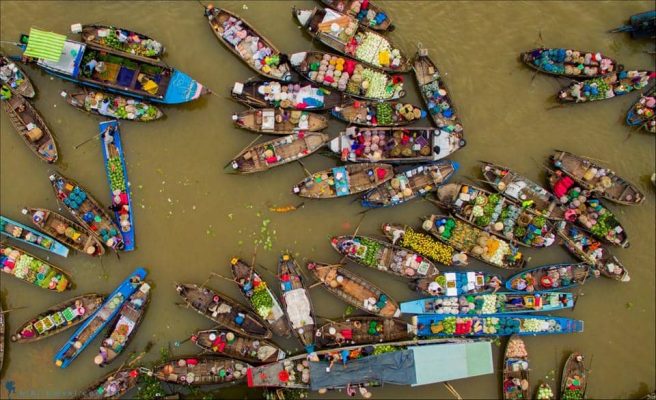
Cai Rang Floating Market.
Cai Rang Floating Market is one of the most attractive destinations in the Mekong Delta, captivating visitors with its unique cultural features and picturesque river scenery. Located about 6 km from the center of Can Tho City, Cái Răng Floating Market is not only a bustling trading spot but also a cultural symbol of the people in the Mekong Delta region. With a long history of formation, this place offers visitors an authentic experience of local life and activities, along with delicious specialties that should not be missed. Follow Ula Travel today!
I. Introduction to the Cai Rang Floating Market
1. Overview of Cai Rang Floating Market
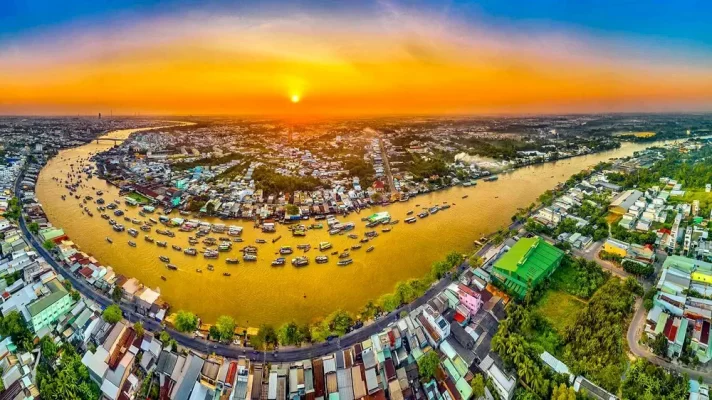
Cai Rang floating market seen from above
Cai Rang Floating Market, the largest and most famous floating market in the Mekong Delta, is a must-visit destination for travelers seeking an authentic cultural experience in Vietnam. Located about 6 km from Can Tho city center, this bustling market offers a fascinating glimpse into the unique river-based lifestyle of the Mekong Delta. From the break of dawn, hundreds of boats gather on the Hau River, trading fresh fruits, vegetables, and local specialties, creating a vibrant scene that has been a way of life for generations.
2. The Unmatched Charm of Cai Rang Floating Market
What makes Cai Rang Floating Market truly special is its distinctive trading style, where boats serve as mobile shops, and goods are advertised by hanging samples on long poles called “cây bẹo.”. This centuries-old tradition reflects the adaptability and resilience of the Mekong Delta’s people, who have embraced the waterways as their primary mode of living and commerce.
Unlike conventional markets, Cai Rang offers visitors an immersive experience, where they can:
- Witness traditional boat-to-boat trading of fresh produce, including tropical fruits like mangoes, durians, and rambutan.
- Enjoy a floating breakfast with local delicacies such as hủ tiếu (rice noodle soup) and bánh mì (Vietnamese baguette) prepared and served directly on boats.
- Interact with friendly local traders, learning about their daily lives and the significance of floating markets in Mekong Delta culture.
3. Why You Shouldn’t Miss Cai Rang Floating Market
Cai Rang Floating Market is more than just a marketplace—it is a living cultural heritage of Southern Vietnam. It showcases the resourcefulness of the people, the richness of local flavors, and the deep connection between life and water in the Mekong Delta. For visitors looking for an authentic and photogenic experience, this floating market provides countless opportunities for stunning photography, cultural discoveries, and unforgettable memories.
Click here: Mekong Delta Tour Package
II. History and Location of Cai Rang Floating Market
Embracing the characteristic charm of the Mekong Delta, Cai Rang Floating Market is not only a magnet for local residents but also a familiar tourist attraction on the itinerary of many adventure-seeking travelers in Can Tho.
Established in the early 20th century, Cai Rang Floating Market served as a trading hub where people from the Mekong Delta region exchanged goods, especially the specialties of the Cuu Long River Delta.
Situated at the confluence of two branches of the Hau River and the Cai Rang River, Cai Rang Floating Market benefits from its strategic location in shallow waters, facilitating easy mooring for boats.
Over time, the number of moored boats at the market increased significantly, turning it into a bustling floating market. In 2016, Cai Rang Floating Market was recognized as a national intangible cultural heritage, becoming a source of pride for the people of the Mekong Delta.
III. Best Time to Visit Cai Rang Floating Market
1. Best Time to Visit Cai Rang Floating Market
The ideal time to visit Cai Rang Floating Market in Can Tho is from December to April because during this period, there is plenty of sunshine and less rain, making it easier to explore the market.
Additionally, this is the time when fruits are in season, so you can indulge in buying the local specialties of the Mekong Delta at the floating market. From May to December, Can Tho experiences the rainy season, sometimes causing trading activities at the market to temporarily halt.
Cai Rang Floating Market convenes very early in the morning, so you can start your unique market exploration journey from 4 a.m. onwards. At this time, numerous boats gather, creating a lively and cheerful atmosphere. Moreover, you’ll have the chance to admire the breathtaking sunrise scenery on the peaceful river.
2. Best Time of Day to Visit Cai Rang Floating Market
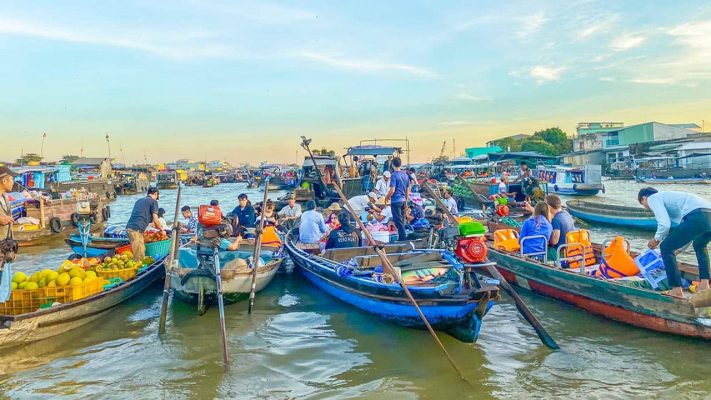
Cai Rang floating market gathers in the early morning.
Unlike markets on land, Cai Rang Floating Market in Can Tho and other floating markets in the Mekong Delta provinces gather very early in the morning. The period from 4 a.m. to 5 a.m. is the most suitable time to visit Cai Rang Floating Market in Can Tho.
During this time, boats have already started racing to the market. When you arrive at the market during this time, you’ll not only immerse yourself in the bustling atmosphere of buyers and sellers but also have the opportunity to witness the stunning scenery of the floating market as dawn breaks. Arriving at the market center around 6 a.m., you can enjoy breakfast right on the boat, which is truly delightful.
You might be like: Discover The Ho Chi Minh City to Mekong Delta Tour
IV. How to Get to Cai Rang Floating Market
Can Tho is the largest urban center in the Mekong Delta and the closest departure point to Cai Rang Floating Market. The market is about 6 km southeast of the city center, making it easy and quick to reach.
1. Renting a Boat from Ninh Kieu Wharf
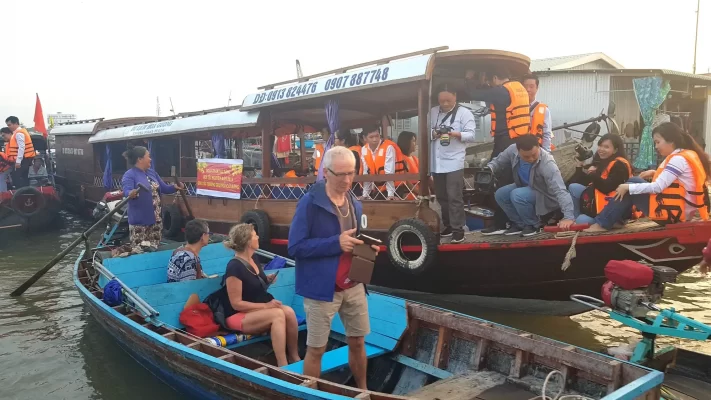
Boat carrying passengers to the floating market
Today, there are many routes serving the exploration of Cai Rang Floating Market in Can Tho, departing from Ninh Kieu Pier. To reach this place, you should rent a boat, vessel, or ferry, depending on the number of people.
If your group is small, consider a small boat. For larger groups, choose a ferry, which will save you a considerable amount of money. Don’t forget to check out the travel guide for many more Can Tho exploration tips!
Below are the boat rental prices at Ninh Kieu Pier for your reference and consideration. Prices may vary depending on the time, especially during holidays and Tet (Vietnamese New Year).
- 1–7 passengers: 500,000 VND/boat
- 8–15 passengers: 600,000 VND/boat
- 16–30 passengers: 700,000 VND/boat
- 31–40 passengers: 800,000 VND/boat
- 40 passengers and above: 900,000 VND/boat
2. Traveling by Motorbike or Taxi to the Boat Wharf
If you don’t want to rent a boat from the city center, you can take a motorbike or taxi to Cai Rang Wharf and rent a boat there.
- Distance: About 6 km from Can Tho city center to Cai Rang Wharf.
- Travel time: Around 15 minutes by motorbike or car.
- Taxi fare: Between 70,000 – 100,000 VND depending on the taxi company.
- Motorbike rental price: Around 120,000 – 200,000 VND per day if you want to ride by yourself.
V. Things to Do in Cai Rang Floating Market
1. The Unique “4 Hanging” Method and “Beo” Trees at Cai Rang Floating Market
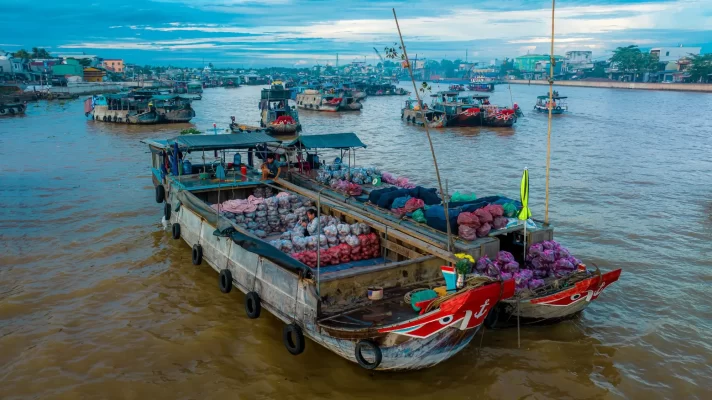
Cargo boats are recognizable by the Beo tree in front.
Cai Rang Floating Market in Can Tho offers a diverse range of goods. Each boat sells different items, from fresh and delicious fruit baskets typical of the Mekong Delta to essential household goods.
Due to the vast space of the floating market and the loud sounds of waves and boat engines, vendors cannot use vocal calls like on land markets. Instead, they hang their goods on a pole called “beo” so that buyers can easily identify the items they need and approach to make a purchase.
The “4 Hanging” method here includes:
Hang and sell: Vendors hang what they sell on the “beo” tree. For example, if they want to sell watermelons, they hang watermelons.
Hang but not sell: This refers to clothes belonging to many families living on boats.
Don’t hang but sell: Only small boats navigate through the market to serve customers with items like noodles, soup, coffee, and sandwiches.
Hang one thing but sell another: When you see vendors hanging a roof leaf, it implies they are selling their boat (the boat is like their home).
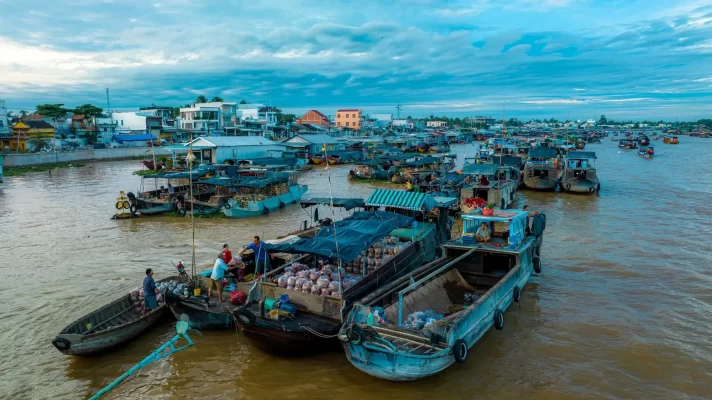
Buy and sell goods from large boats to small boats
People trade goods among boats by tossing or passing items from one boat to another. Immersing yourself in the market atmosphere, you can learn about the riverine life of the locals, who live in their “mobile homes,” equipped with TVs, kitchenettes, and ornamental plants.
Ever wondered why Cai Rang Floating Market sells so many fruits? It’s because all the floating markets in this region are located near fruit orchards, serving as distribution points to other places.
Therefore, by visiting the floating market, you’ll have the opportunity to indulge in a variety of seasonal fruits such as pineapples (aromatic), mangoes, strawberries, watermelons, oranges, coconuts, rambutans, mangosteens, bananas, pomelos, and more.
Start your journey with: Best of Southern Vietnam
2. Listening to Southern Vietnamese Traditional Music on the River
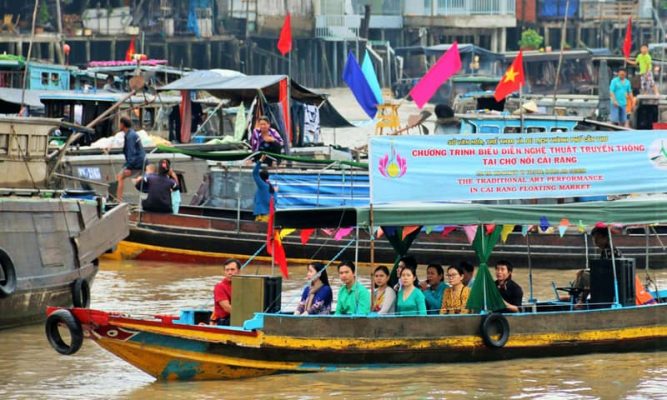
Southern Vietnamese traditional music at Cai Rang floating market
One of the most enchanting experiences at Cai Rang Floating Market in Can Tho is provided by a boat of Southern Vietnamese traditional music performers every Saturday and Sunday.
This musical ensemble, organized by the Department of Culture, Sports, and Tourism of Can Tho, cruises along the river, delighting both locals and tourists alike. If you’re interested in arranging a private performance, reaching out to the department is the way to go!
Immersing yourself in the melodies steeped in Southern Vietnamese culture while taking in the bustling scenes of the floating market from the comfort of a boat on the Hau River is an experience that evokes both tranquility and excitement.
The symphony of boat engines humming, the gentle rhythm of water against the vessel, and the caress of the cool breeze create an atmosphere that captivates the senses and enamors visitors with the serene charm of the region.
More details: Discover A Glimpse of The Mekong Delta
3. Exploring the Culinary Delights on the River
Arriving at the floating market around 5 or 6 a.m., the perfect time for breakfast is around 7 a.m. Contrary to expectations, the market isn’t just a hub for agricultural produce like sweet potatoes, pumpkins, and cassavas but also offers a delectable array of breakfast options.
To cater to the diverse tastes of both locals and visitors, numerous small boats traverse the river, vending breakfast staples such as porridge, pork rib rice, noodle soup, and stir-fried noodles, accompanied by beverages ranging from tea, coffee, coconut water, and soy milk. And don’t be surprised if you chance upon a riverside eatery right on the water’s edge!
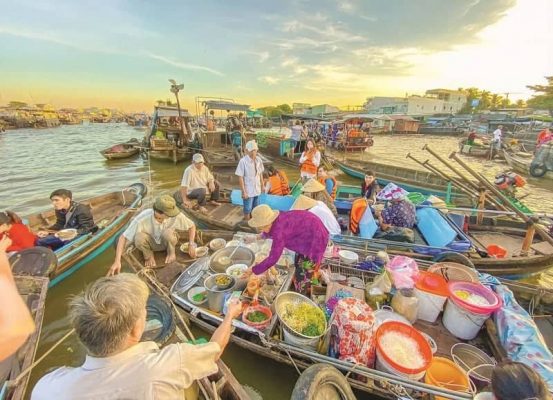
Explore the food market on the river
Among the myriad of mouthwatering dishes available, hủ tiếu (rice noodle soup) and cà phê kho (Vietnamese condensed milk coffee) stand out as must-try specialties at Cai Rang Floating Market in Can Tho. These culinary delights are a testament to the cultural richness of the riverine region.
Talking about the birth of “hủ tiếu lắc” (shaking noodle soup), it originated from the practice of selling noodle soup from boats. Whenever a noodle soup boat stopped, customers would buy a bowl and eat right there. Without tables and chairs like on land, this noodle soup was consumed on the swaying boat, hence the name “hủ tiếu lắc” (shaking noodle soup).
In the past, for this specialty dish, people used porcelain bowls and waited for customers to finish eating before retrieving the bowl. Nowadays, to save time, many boat vendors use plastic bowls for takeout.
4. Eat Fruit to Your Heart’s Content in the Garden
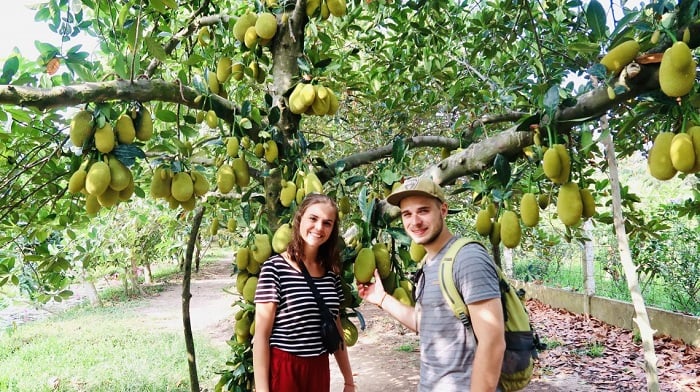
Ba Cong fruit garden
The next destination is the Ba Cong fruit garden. Coming here, after visiting the garden and taking photos with the fruit trees, you will enjoy a small plate of fruits with about 4-5 types depending on the season (this is included in the initial fee). If you want to buy fruit here, you can tell the garden owner. But we’re from the West, so we’re very easy-going, so we always give extras for free.
Ticket to the fruit garden: 15,000 VND/person
5. Participate in Making Noodles at a Traditional Noodle Oven.
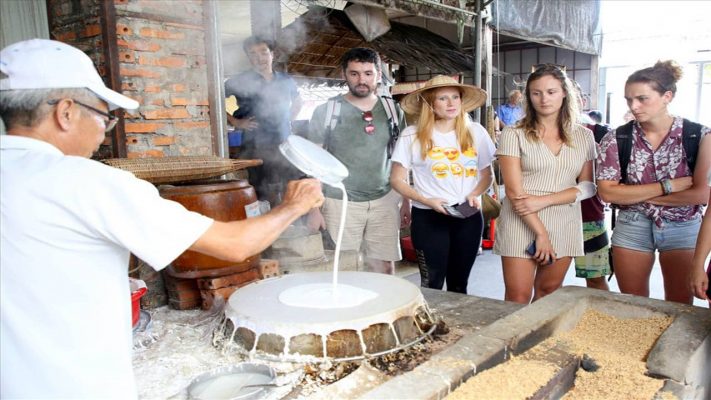
Traditional noodle oven in Can Tho
The traditional noodle oven is an attractive tourist destination when coming to Can Tho. Coming here, you will be able to visit the traditional noodle-making process and enjoy the unique, one-of-a-kind “Noodle Pizza.”.
This traditional noodle oven has been around for a long time. Coming here, you will be able to visit the stages of making noodles: cooking rice paper from flour, drying, cutting into noodles, and other stages.
In particular, not only will you be able to see, but you will also be able to try some of the traditional steps of making noodles. This place has all kinds of noodles with many colors; each color is made from natural ingredients. Red from gac, green from pandan leaves, white from rice flour…
VI. Travel Tips for Visiting Cai Rang Floating Market
To make the most out of your trip to the floating market, jot down these useful travel tips:
- Check the weather forecast for Can Tho beforehand to determine the best time to visit.
- When renting a boat to the floating market, ensure you gather accurate information about the boat owner, negotiate prices, and agree on the itinerary and sightseeing spots.
- Avoid paying any deposits upfront; if necessary, obtain a clear receipt.
- Pay attention to the ideal time frame for visiting the floating market to fully immerse yourself in the experience.
- Consider combining your visit to the floating market with famous tourist spots around Can Tho that are accessible by boat, such as the fruit orchards or My Khanh tourist village.
- While onboard, refrain from leaning over the boat’s edge to prevent any unfortunate accidents, and remember to wear a life jacket.
- Inquire about prices before indulging in breakfast dishes like porridge, rice vermicelli with fish sauce, or noodle soup at the boat eateries along the river.
- Avoid excessively bargaining without the intention to purchase, especially with boats selling fruits and agricultural products.
In conclusion, Cai Rang Floating Market is a must-visit destination in the Mekong Delta, offering an authentic glimpse into the region’s rich culture and bustling trade life. From colorful boats filled with tropical fruits to the unique experience of enjoying breakfast on the water, every moment here immerses visitors in the vibrant local lifestyle.
If you’re planning a trip to Southern Vietnam, don’t miss the chance to explore this iconic floating market. It’s an unmissable experience that captures the heart and soul of the Mekong Delta. Book your trip to Cai Rang Floating Market today and experience the vibrant culture of the Mekong Delta!
See more: Mekong Delta travel tips



